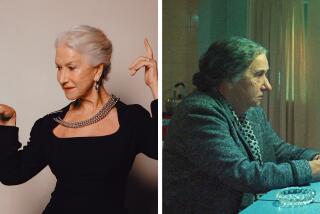Hair Today, More Tomorrow
- Share via
Movie stars have been doing it for years, but now anyone who wants longer, thicker locks can have extra strands sewn, tied or glued to one’s own hair.
Hair extensions are not new, but until the last few months most county residents were unaware of the technique to add length, body, and thickness to thin, damaged or scrawny hair.
“It’s just starting to grab hold in Orange County,” says Alice Meyers, manager of the Impulse hair salon in Newport Beach.
“It’s expensive, so a lot of (my customers) are wealthy women who can afford whatever it takes to look good,” she adds.
Hair extensions, also known as hair weaving, can be done with human or artificial hair in a number of ways, but the most common methods are: the braid (or tract) technique in which extra strands of hair are sewn onto braids (strung across the scalp like corn rows) created from the customer’s hair; the tying (also called pole weaving or French lacing) method in which individual strands are tied to the customer’s hair; and the bonding method in which strands are glued to the customer’s hair.
Meyers says the tying method at her salon costs between $500 and $800, depending on how long the strands are and how many are needed. The braid method costs between $275 and $300 and bonding costs about $40 to $175. (All the stylists interviewed charge between $200 and $800 for braid or tie extensions, depending on length and amount of hair; bonding prices usually start around $40.)
Most extensions today are done with human hair, although some salons are using a technique with synthetic hair called Monofibre, which is less expensive than real hair. All the techniques except bonding usually take several hours to complete.
But despite the cost in time and money, customers report happy results.
“It’s made my life wonderful,” says Michelle Frenz, 18, who has been wearing extensions for more than a year. “I get more attention and looks from the guys. My hair was really short and I wanted it long and I was just getting impatient.”
Frenz says she has no intention of ending the extensions. “I can’t think of anything better to spend my money on than making myself look better.”
Sylvia Shapiro says she considered a wig until she heard about extensions.
“I love it,” says Shapiro, who has been a manicurist for 23 years. “It’s marvelous because it fills up a big spot on the top of my head and I feel like a new person.”
Meyers says the bonding method, which is the technique chosen by Shapiro, is for extreme cases--people who don’t have enough hair to have strands attached by tying or sewing. It only lasts two to four weeks, compared to the braid method, which lasts about six weeks, or the tie method, which lasts about three months.
Customers who have had strands sewn onto a braid at the scalp must return every six weeks or so for what is called tightening, or adjusting the extension to accommodate the customer’s hair growth. Most salons charge $100 to $200 for this. When the other two methods grow out, the extensions are redone entirely.
Eugenie Herman of Eugenie’s Hair Stylists in Santa Ana has been weaving extensions for eight years. She recommends the braid or tie method and tries to steer customers away from bonding.
“The glue can be irritating to the scalp and if you use any heat, like from a blow dryer, the glue melts and the (strands) fall out,” she says.
Extensions are usually done with human hair from Italy or Indonesia, and are usually styled and colored before attachment, says Herman. Most of the extensions can be shampooed and blow dried, she adds.
Tacy Gonzalez, a stylist at Anthony Michaels Salon in Costa Mesa, says in addition to women with thin hair hoping to add volume, extensions are for men and women who “have always wanted that long hair look but couldn’t grow it.”
Gonzalez was taught by Beka Ledford, a stylist at Finamore’s Hair Salon in Newport Beach, who has been doing extensions for 2 1/2 years and who says that extensions make up 75% of her styling business.
Meyers says extensions allow women who have been embarrassed about thin hair to face life with much more confidence.
“There are so many women who don’t even want to go out into the world because they hardly have any hair,” she says. “Wigs are great, but when you wear wigs every day of your life, your scalp doesn’t get sunshine or oxygen and it can’t breathe. It’s like laying carpet over grass.”
Not everyone is as enthusiastic as Meyers, however. Although more than a dozen calls to area dermatologists yielded no reports of scalp or hair problems developing from the styling technique, some doctors said they would be leery of using glue near the scalp or tying the strands too tightly.
“I don’t know how tightly they tie these strands, but if they got too tight there could develop a slight hair loss,” says Stephen Scheinberg, a Newport Beach dermatologist. “And I’m sure that a scalp problem could develop from the glue.”
“In my practice I haven’t seen any of this, but when one uses glue, one always runs the risk of allergic reactions,” says Gary L. Hardegen, an Anaheim dermatologist.
Herman, the Santa Ana stylist, agrees that the glue can be dangerous. But she says problems associated with the tied extensions are minor and temporary.
“Some people are tender-headed and they might feel some discomfort in pulling,” she says. “But if the scalp is in normal condition, they won’t feel anything. Even if they do, it’s just a temporary condition.”


